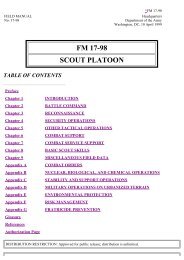FM 3-25.26 MAP READING AND LAND NAVIGATION
FM 3-25.26 MAP READING AND LAND NAVIGATION
FM 3-25.26 MAP READING AND LAND NAVIGATION
Create successful ePaper yourself
Turn your PDF publications into a flip-book with our unique Google optimized e-Paper software.
d. Coverage Diagram. On maps at scales of 1:100,000 and larger, a coverage diagram may be used. It isnormally in the lower or right margin and indicates the methods by which the map was made, dates ofphotography, and reliability of the sources. On maps at 1:250,000 scale, the coverage diagram is replaced by areliability diagram.e. Special Notes (24). A special note is any statement of general information that relates to the mapped area. Itis normally found in the lower right margin. For example: This map is red-light readable.f. User's Note (25). This note is normally located in the lower right-hand margin. It requests cooperation incorrecting errors or omissions on the map. Errors should be marked and the map forwarded to the agencyidentified in the note.g. Stock Number Identification (26). All maps published by the DMA that are in the Department of the Armymap supply system contain stock number identifications that are used in requisitioning map supplies. Theidentification consists of the words "STOCK NO" followed by a unique designation that is composed of theseries number, the sheet number of the individual map and, on recently printed sheets, the edition number. Thedesignation is limited to 15 units (letters and numbers). The first 5 units are allotted to the series number; whenthe series number is less than 5 units, the letter "X" is substituted as the fifth unit. The sheet number is the nextcomponent; however, Roman numerals, which are part of the sheet number, are converted to Arabic numerals inthe stock number. The last 2 units are the edition number; the first digit of the edition number is a zero if thenumber is less than 10. If the current edition number is unknown, the number 01 is used. The latest availableedition will be furnished. Asterisks are placed between the sheet number and the edition number when necessaryto ensure there are at least 11 units in the stock number.h. Conversion Graph (27). Normally found in the right margin, this graph indicates the conversion ofdifferent units of measure used on the map.3-3. TOPOGRAPHIC <strong>MAP</strong> SYMBOLSThe purpose of a map is to permit one to visualize an area of the earth's surface with pertinent features properlypositioned. The map's legend contains the symbols most commonly used in a particular series or on that specifictopographic map sheet. Therefore, the legend should be referred to each time a new map is used. Every effort is madeto design standard symbols that resemble the features they represent. If this is not possible, symbols are selected thatlogically imply the features they portray. For example, an open-pit mining operation is represented by a small blackdrawing of a crossed hammer and pickax.a. Ideally, all the features within an area would appear on a map in their true proportion, position, and shape.This, however, is not practical because many of the features would be unimportant and others would beunrecognizable because of their reduction in size.b. The mapmaker has been forced to use symbols to represent the natural and man-made features of the earth'ssurface. These symbols resemble, as closely as possible, the actual features themselves as viewed from above.They are positioned in such a manner that the center of the symbol remains in its true location. An exception tothis would be the position of a feature adjacent to a major road. If the width of the road has been exaggerated,then the feature is moved from its true position to preserve its relation to the road. Field Manual 21-31 gives adescription of topographic features and abbreviations authorized for use on our military maps.3-4. MILITARY SYMBOLSIn addition to the topographic symbols used to represent the natural and man-made features of the earth, militarypersonnel require some method for showing identity, size, location, or movement of soldiers; and military activitiesand installations. The symbols used to represent these military features are known as military symbols. These symbolsare not normally printed on maps because the features and units that they represent are constantly moving or changing;military security is also a consideration. They do appear in special maps and overlays (Chapter 7). The map user drawsthem in, in accordance with proper security precautions. Refer to <strong>FM</strong> 101-5-1 for complete information on militarysymbols.3-5. COLORS USED ON A MILITARY <strong>MAP</strong>By the fifteenth century, most European maps were carefully colored. Profile drawings of mountains and hills were











